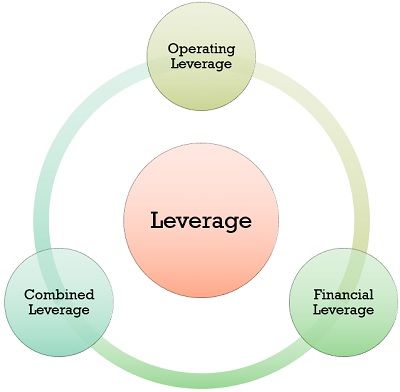Definition: In financial management, leverage implies the quantum of debt or borrowed funds deployed by a firm to finance its operations, procurement of assets like inventory, plant, building, etc. expansion projects, acquisition of new business and so forth.
It ascertains the firms potential in employing borrowed funds (long-term) that carry fixed return, in order to increase the returns to the shareholders.
Measures of Leverage
In general, the three popularly known types of leverage which are used in the financial analysis are operating leverage, financial leverage and combined leverage.
Leverage indicates the sensitiveness of a financial variable when there is a change in another financial variable, and this sensitiveness is measured in ratio, called a Degree of leverage.
Operating Leverage (OL)
Operating Leverage implies the use of an asset that carries a fixed cost, expecting that it will generate enough returns that may cover all the fixed and variable costs. The three factors which determine operating leverage are the amount of fixed cost, variable contribution margin, and volume of sales.
Where Contribution (C) = Sales – Variable Cost
EBIT = Contribution – Fixed Cost
Degree of Operating Leverage (DOL): It indicates the percentage change in profits as a result of the percentage change in sales. It marks the company’s potential to employ fixed operating costs to amplify the result of changes in sales on the Earnings before interest and tax (EBIT).
A positive DOL indicates that company’s operating level is above the break-even point, whereas a negative DOL indicates that the company’s operating level is below the break-even point. In addition to this, when the DOL is 0, it means that the company’s operating level is equal to the break-even point.
Financial Leverage (FL)
Financial Leverage implies the employment of those funds by the company which carry a fixed return with the aim of increasing the earnings per share to the common stockholders.
Where, EBIT = Contribution – Fixed Cost
EBT = EBIT – Interest
Degree of Financial Leverage (DFL): It determines the percentage change in Earnings per share (EPC) to the percentage change in Earnings before Interest and Tax (EBIT). It expresses the firms potential to employ fixed financial charges in order to magnify the result of changes in EBIT on EPS.
A positive DFL signifies that the level of Earnings before interest and tax (EBIT) is more than fixed financial charge, whereas a negative DFL means EBIT level is less in comparison to the fixed financial charge. Additionally, when the DFL is infinite or undefined, it means that the firm is operating at the financial break-even point, i.e. no profit no loss.
Combined Leverage (CL)
Combined Leverage is a mix of operating and financial leverage which emphasizes the change in sales on the earnings per share to the common stockholders. It refers to the probable use of both financial and operating fixed cost, that maximizes the result of sales volume on the company’s earning per share.
Degree of Combined Leverage (DCL): It expresses the percentage change in the earnings per share to the percentage change in sales, in a ratio. In short, it indicates the effect on EPS, if there is a change in sales volume.
The use of debt in the company’s capital structure, adds to the risk of bankruptcy. However, it also increases the company’s profitability and returns on equity, as the owner’s equity is not further divided by issuing shares to raise funds.
When the capital structure of a firm consists of a lot of debt, then that firm is regarded as highly levered, whereas when the firm’s capital structure, contains only owner’s funds and no borrowed funds, then that firm is said to be unlevered.





Leave a Reply